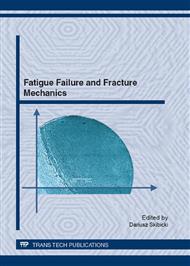[1]
J.S. Bendat, A.G. Pierdol, Methods of analysis and measurement of random signals, (in Polish), PWN, Warszawa, 1976.
Google Scholar
[2]
J. Čačko, M. Bìlý, J. Bukoveczky, Random processes: measurement, analysis and simulation, ELSEVIER, Amsterdam – Oxford – New York – Tokyo, 1988.
Google Scholar
[3]
FITNET Fitness-for-Service Procedure – Final Draft MK7, 2006.
Google Scholar
[4]
M. Huck, W. Schultz, R. Fischer, G. Kobler, A standard random load sequence of Gaussian type recommeded for general application in fatigue testing, LBF-Report no. 2909, IABG-Report no. TF-570, p.21, 1976.
Google Scholar
[5]
S. Kocańda, J. Szala, Fundamentals of fatigue calculations, (in Polish), PWN, Warszawa, 1997.
Google Scholar
[6]
B. Ligaj, Experimental and calculational analysis of Steel fatigue life in random conditions of wide range spectra, (in Polish), Monographs, 2nd part of monograph: Two-parametric fatigue characteristics of steel and their experimental verification, Publishing House of Operation Technology Institute - State Research Institute, Radom, 2011.
Google Scholar
[7]
B. Ligaj, G. Szala, Loading analysis in tests and calculations of fatigue life of constructional elements – on the example of operating loadings of a car, (in Polish), Logistyka nr 6, 2009.
Google Scholar
[8]
B. Ligaj, G. Szala, Experimental Verification of two-parametic models of fatigue characteristics by using the tests of S355J0 steel as an example, Polish Maritime Research 1/2010 (2010), 39-50.
DOI: 10.2478/v10012-010-0004-5
Google Scholar
[9]
B. Ligaj, G. Szala, A fatigue life calculation method or constructional elements with a use of two-parametric fatigue characteristics, Acta Mechanica et Automatica, vol.3 no.2 (2009), 47-51.
Google Scholar
[10]
T. Łagoda, K. Walat, Methods of service loading performance in control systems of fatigue machines, Acta Mechanica et Automatica, vol. 5, no. 1 (2011), 47-52
Google Scholar
[11]
ASTM standard, Standard Practices for cykle counting in fatigue analysis, ASTM Designation: E 1049-85 (Reapproved 1990).
Google Scholar
[12]
Description of a Fighter Aircraft Loading Standard for Fatigue, ICAF, 1976.
Google Scholar
[13]
G. Szala, Theoretical and experimental analysis of two-parametric fatigue life characteristicsm of constr, (in Polish), Monographs, 1nd part of monograph: Two-parametric fatigue characteristics of steel and their experimental verification, Publishing House of Operation Technology Institute - State Research Institute, Radom, 2011.
Google Scholar
[14]
J. Szala, Hypotheses of fatigue damage accumulation, (in Polish), Monographs, University of Technology and Agriculture, Bydgoszcz 1998.
Google Scholar
[15]
J. Szala, Loads and fatigue life of machine elements, (in Polish), University of Technology and Agriculture, Bydgoszcz 1989.
Google Scholar


